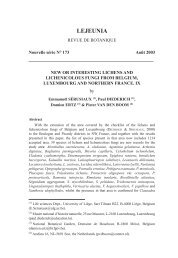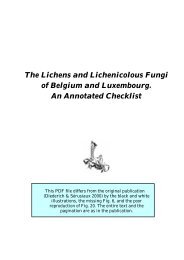A Synopsis of the Genera Skyttea, Llimoniella and - Lichens of ...
A Synopsis of the Genera Skyttea, Llimoniella and - Lichens of ...
A Synopsis of the Genera Skyttea, Llimoniella and - Lichens of ...
Create successful ePaper yourself
Turn your PDF publications into a flip-book with our unique Google optimized e-Paper software.
460 THE LICHENOLOGIST Vol. 32<br />
Careful studies <strong>of</strong> numerous lichenicolous leotialean species have led us to<br />
conclude that <strong>Skyttea</strong> cruciata is congeneric with Geltingia stereocaulorum,<br />
<strong>Llimoniella</strong> fuscoatrae, L. neglecta, L. pubescens <strong>and</strong> several undescribed taxa.<br />
They all share <strong>the</strong> following characters: ascomata blackish, initially partly<br />
immersed, <strong>of</strong>ten urceolate, exciple <strong>of</strong>ten covering <strong>the</strong> disc when young,<br />
epihymenium with a green, K+ olivaceous pigment (in some species also<br />
present in <strong>the</strong> upper exciple), exciple with a brownish, K — pigment, ascus<br />
wall apically not thickened, no reactions with iodine (all parts I — <strong>and</strong> KI — ),<br />
paraphyses easily separating in KOH with pressure, ascospores O(-l)-septate,<br />
hyaline, smooth, ellipsoid to fusiform. The exciple is composed <strong>of</strong> ± isodiametric<br />
cells below, but <strong>of</strong> narrow, elongate, sometimes almost filiform cells<br />
above; <strong>the</strong>se elongate cells are ei<strong>the</strong>r embedded in a gel <strong>and</strong> are thus part <strong>of</strong> <strong>the</strong><br />
exciple s. str., or <strong>the</strong>y are free <strong>and</strong> form excipular hairs. We initially hesitated<br />
to include species with <strong>and</strong> without excipular hairs in <strong>the</strong> same genus, but as<br />
both situations have been observed in R. pertusariae, described below, in <strong>the</strong><br />
same specimen <strong>and</strong> on <strong>the</strong> same host thallus, it is clear that this character is <strong>of</strong><br />
a minor taxonomic importance in this group <strong>of</strong> fungi.<br />
These species differ from <strong>Skyttea</strong> by <strong>the</strong> apically non-thickened ascus wall,<br />
<strong>the</strong> completely different excipular margin (see Figs 1A, 13) <strong>and</strong> hairs, <strong>the</strong><br />
hymenium with paraphyses easily separating in KOH with pressure, <strong>the</strong><br />
intensively green epihymenium <strong>and</strong> <strong>the</strong> different ascomatal opening.<br />
They are very distinct from <strong>the</strong> known lichenicolous leotialean fungi with<br />
excipular hairs, Echinodiscus lesdainii (Etayo & Diederich 2000), Polydesmia<br />
lichenis Huhtinen & R. Sant. (Hyaloscyphaceae; Huhtinen & Santesson 1997)<br />
<strong>and</strong> Unguiculariopsis spp. {Hyaloscyphaceae [H.-O. Baral pers. comm.]; e.g.<br />
Rambold & Triebel 1990; Zhuang 1988; see also below). We initially<br />
wondered if <strong>the</strong>se species belong to <strong>Llimoniella</strong>, in which two <strong>of</strong> <strong>the</strong>m were<br />
described, <strong>and</strong> two more have been combined later. The type species <strong>of</strong><br />
<strong>Llimoniella</strong> <strong>and</strong> all o<strong>the</strong>r species included by us in <strong>the</strong> same genus, have no<br />
excipular hairs, <strong>and</strong> present a different, reddish, K+ purplish violet excipular<br />
pigment, <strong>the</strong> green, K+ olivaceous epihymenial pigment being absent;<br />
<strong>the</strong> exciple, which is more strongly developed at <strong>the</strong> base <strong>of</strong> <strong>the</strong> ascomata, is<br />
entirely composed <strong>of</strong> ± isodiametric cells <strong>and</strong> does not or only hardly<br />
covers <strong>the</strong> ascomatal disc. As some <strong>of</strong> <strong>the</strong>se differences, such as <strong>the</strong><br />
different pigmentation, might just be important at specific <strong>and</strong> not at<br />
generic level, we hesitated for a long time in separating <strong>the</strong> '<strong>Skyttea</strong><br />
cruciata-group' from <strong>Llimoniella</strong>. We believe now that <strong>the</strong>re is a strong case<br />
in favour <strong>of</strong> this separation. The technique required consists <strong>of</strong> examining<br />
apo<strong>the</strong>cial sections in C (commercial bleach), which lets <strong>the</strong> dark excipular<br />
pigments disappear completely, allowing an accurate study <strong>of</strong> <strong>the</strong> excipular<br />
structure. A detailed study <strong>of</strong> most species involved confirmed that <strong>the</strong><br />
excipular structure is clearly different in <strong>the</strong>se two groups <strong>of</strong> fungi (see Figs<br />
7, 8). The outer excipular cells in <strong>Llimoniella</strong> are ± isodiametric, <strong>of</strong>ten<br />
± swollen, whilst those in <strong>the</strong> l S. cruciata-group' are narrowly elongate.<br />
These ± linear outer excipular cells in <strong>the</strong> latter group may well be<br />
interpreted as excipular hairs, which in some species are free <strong>and</strong> visible,<br />
whilst in o<strong>the</strong>rs <strong>the</strong>y are embedded in an excipular gel, <strong>the</strong> exciple thus<br />
appearing as devoid <strong>of</strong> hairs.





